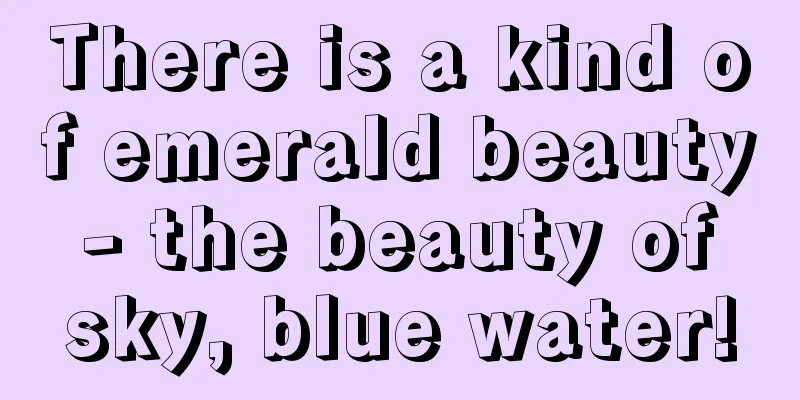Teach you to easily identify dyed jade in 3 steps, so you never have to worry about being cheated again!

|
In the jade circle, there is a type of jade called "C goods". This kind of jade is made by unscrupulous businessmen who dye and package low-quality jade to sell it as high-quality jade in order to make huge profits. Observation by eyes and ears, suitable for experienced people With the advancement of technology, dyed jade can now be so authentic that novices cannot tell the difference. But for experienced experts, they can tell whether a piece of jade has been dyed just by looking and listening. How is it done? ① Visual observation The glossiness and transparency of dyed jade are lower than those of natural jade, and the color is very unnatural, giving people a feeling of great contrast. The color is not correct, evil, or too dazzling and uniform, and there may be dye residues in the cracks. ② Sound Identification Some inferior quality jade cannot be dyed directly, but need to be washed with acid and alkali chemical reagents before dyeing. The internal structure of jadeite that has been washed with acid and alkali has been destroyed, and it will make a dull sound when knocked. ③ Observe the color root Dyed jade will have a silky structure, the color edge layering is very blurred, the color appears to be floating, and the transition is unnatural. It is worth mentioning that some varieties of jade do not have color roots, such as hibiscus, dragon stone, high-end green jade, etc. Therefore, if you cannot see the color root, don’t rush to judge that a certain piece of material is fake jade. In addition, for jadeite with good water quality, the color root diffusion will be very obvious, otherwise it will not be obvious. Another point is that when the oil in human skin penetrates into the cracks of jade, it will make the structure of jade tighter, thereby increasing the transparency of jade and spreading the color roots. ④ Magnifying glass inspection Using a magnifying glass, you can identify whether purple jadeite has been dyed. For example, on a piece of purple jade, do you observe whether the white surrounds the purple, or the purple surrounds the white? If white is surrounded by purple, it means it is natural jade; if purple is surrounded by white, it means it is dyed jade. Tips for identification, the best choice for beginners The method used by experts to identify whether jade is dyed seems simple, but it requires long-term experience accumulation. Only by watching, asking and learning more can you apply it flexibly. If novices want to get started right away and simply identify dyed jadeite, why not use some folk remedies? ① Soak in boiling water Soak the jade to be tested in boiling water for several hours. If it is dyed jade with inorganic materials or green polishing powder, it will fade and turn the water green. If the water does not turn green, it does not mean that it is not dyed, but it is just because the unscrupulous merchants are too clever, and further judgment is needed. ② Observe under incandescent light Observe the jadeite to be tested under the light of an incandescent lamp. If it turns red, it means it has been artificially dyed; if it does not turn red, it may or may not be dyed, and further identification is needed to determine its authenticity. ③ Ultraviolet fluorescent lamp The most effective way to determine whether jade is dyed is to use ultraviolet fluorescent light. If it is natural jade, there will be no fluorescent reaction; if it is dyed jade, there will definitely be a fluorescent reaction. For example, jadeite dyed purple has a very obvious fluorescent reaction. With professional tools, accurate and effective Finally, if the above methods still cannot help you determine whether the jade is dyed, the following two methods may be helpful. ① Identification of Zachary filter Jadeite that has been irradiated and its color changed cannot be identified using the methods mentioned above, but it can still be judged through a Charpentier color filter. First, for jadeite that has been irradiated to change its color, the color only exists on the surface and is distributed in ring-shaped or patchy forms; the jade is blue in color; the structure shows signs of being bombarded, which is manifested in varying shades of color; it appears purple-red under a Charles Schmidt filter. ② Chemical reagents Prepare some dilute hydrochloric acid or "dyestuff remover", dip a cotton swab in it, and apply it on the dyed jade. You will find that the color becomes lighter and there is dye on the cotton swab. fruit fcpf99 feicuibbs1 fcgc60 |
<<: The most material-consuming piece of jade jewelry!
>>: Tips for identifying jadeite - the "three-look" technique for jadeite
Recommend
What do the "flower" and "green" in jadeite flower green refer to?
There are thousands of pieces of jade knowledge, ...
Subvert tradition! The jade Buddha he carved was sold for 12 million
The first time I saw Master Wang’s Baby Buddha se...
How to identify the authenticity of jadeite, learn three tricks to avoid being fooled
How to distinguish real and fake jadeite? Learn t...
When playing with jade, do you know the places that jade is "afraid of"?
Jade is known as the "King of Jade" for...
practical! Experts summarize the "seven-word mantra" for selecting jadeite. If you don't read it, you will suffer a loss.
As more and more people love and wear jade, the v...
The jadeite that was so cracked that I wanted to throw it away was cleverly carved.
This is a piece of violet and yellow sand-skin ja...
How to polish jadeite correctly? People who don't understand are still doing this, and they have learned
Jade appears around us more and more frequently. ...
The jadeite carving pieces are so beautiful
The piece of jadeite with a clear bottom and gold...
When buying jade gifts, it is important to understand the meaning of jade
Jade has rich cultural connotations, various styl...
The combination of jade necklace and clothes is both retro and modern, making you beautiful and full of personality
Jade necklaces are divided into plain jade neckla...
My opinion on jade carving: How to grade jade carving?
After seeing some critical comments from friends ...
The meaning of violet jade is beautiful and unique, and women love it.
In the jade world, there is a special variety - v...
I didn't expect that an inconspicuous material could be carved so perfectly.
Jade has innate natural beauty, and a good jade c...
From ancient times to the present, the elders have always preferred jade, which is related to this culture.
From ancient times to the present, most elders li...
A touch of green, a touch of purple, this spring-colored jade is so beautiful
Jade has many colors. Green, yellow, red, black, ...









